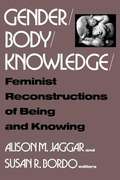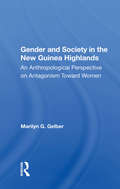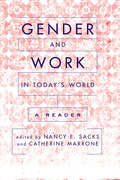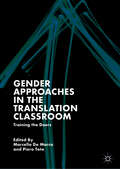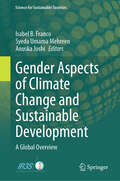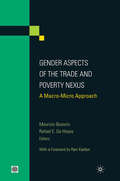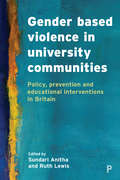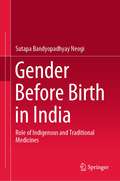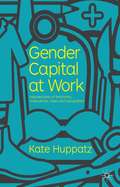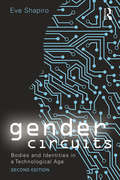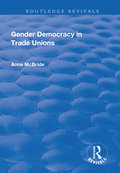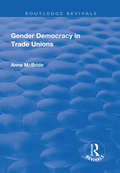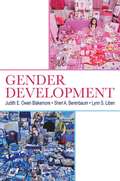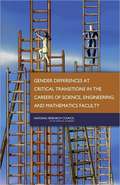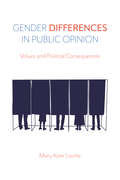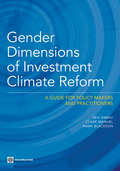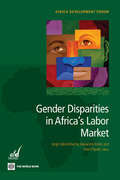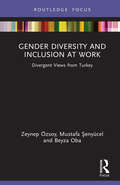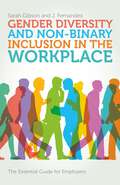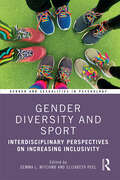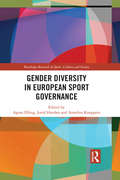- Table View
- List View
Gender / Body / Knowledge: Feminist Reconstructions of Being and Knowing
by Susan R. Bordo Alison M. JaggarThe essays in this interdisciplinary collection share the conviction that modern western paradigms of knowledge and reality are gender-biased.
Gender And Class In English Asylums, 1890–1914
by Louise HideAn unprecedented number of people were sent to 'lunatic asylums' in the nineteenth century. But what was life like inside? How was order maintained? And why were so many doctors on the verge of a breakdown themselves? This book provides a glimpse into the lives of patients and staff inside two London asylums at the turn of the twentieth century.
Gender And Society In The New Guinea Highlands: An Anthropological Perspective On Antagonism Toward Women
by Marilyn G. GelberThe societies of the New Guinea Highlands are among the last-contacted horticulturalist peoples of the world. Endemic warfare, elaborate systems of exchange, flamboyant personality styles, and exaggerated forms of antagonism between the sexes have made them a subject of interest to anthropologists for three decades. This book examines the relationship between the sexes, especially the attitudes and behavior of men toward women, as a result of the economic, political, and structural constraints of Highland social organization. Hostility toward women, which is evident in a high level of violence toward women and an articulated fear of association with them, is given special attention. Dr. Gelber's study is unique not only because it treats gender relations in the entire culture area of the Highlands, but also because a broad array of types of anthropological analysis—ecosystemic, population-regulatory, economic, sociopolitical, psychological, and ideational—are considered for their relevance to the phenomenon of intersexual hostility. The author's emphasis on underlying problems of explanation and theory, as well as the treatment of attitudes and beliefs as a function of socioeconomic constraints, is a departure from previous modes of analysis and raises new issues in anthropological theory and in the study of gender.
Gender And The Politics Of History
by Joan Wallach ScottWinner, in the original edition, of the 1989 Joan Kelly Prize of the American Historical Association, this landmark work from a renowned feminist historian is a trenchant critique of women's history and gender inequality. Exploring topics ranging from language and gender to the politics of work and family, Gender and the Politics of History is a crucial interrogation of the uses of gender as a tool for cultural and historical analysis. The revised edition--in addition to providing a new generation of readers with access to a classic text in feminist theory and history--reassesses the book's fundamental topic: the category of gender. In provocatively arguing that gender no longer serves to destabilize our understanding of sexual difference, the new preface and new chapter open a critical dialogue with the original book.
Gender And Welfare States In East Asia
by Sirin Sung Gillian PascallContributors address questions about gender equality in a Confucian context across a wide and varied social policy landscape, from Korea and Taiwan, where Confucian culture is deeply embedded, through China, with its transformations from Confucianism to communism and back, to the mixed cultural environments of Hong Kong and Japan.
Gender And Work In Today's World: A Reader
by Nancy SacksPromoting gender equality through balanced analysis of both sexes, Gender and work in Today's World: A Reader explores the experiences of both men and women in the work force, focussing especially on gender-non-traditional jobs (i.e. men as nursed and women in the police force) and non-traditional work structures (i.e. Part-time,temporary, and odd-hour work), work over the life course, and sexual harassment.
Gender Approaches in the Translation Classroom: Training the Doers
by Marcella De Marco Piero TotoThis volume examines strategies for embedding gender awareness within translation studies and translator training programmes. Drawing on a rich collection of theoretically-informed case studies, its authors provide practical advice and examples on implementing gender-inclusive approaches and language strategies in the classroom. It focuses on topics including, how to develop gender-inclusive practices to challenge students’ attitudes and behaviours; whether there are institutional constraints that prevent trainers from implementing non-heteronormative practices in their teaching; and how gender awareness can become an everyday mode of expression. Positioned at the lively interface of gender and translation studies, this work will be of interest to practitioners and scholars from across the fields of linguistics, education, sociology and cultural studies.
Gender Aspects of Climate Change and Sustainable Development: A Global Overview (Science for Sustainable Societies)
by Isabel B. Franco Syeda Umama Mehreen Anuska JoshiThis book addresses how sustainability discourse and advocacy can translate to impactful policies especially when bridging the divide between sustainability, climate change and gender. The book explores various areas, such as conservation, climate action, sustainable fashion, and corporate sustainability, and defines the existing sustainability gaps in the selected cases (country/sector/region). It highlights the value of sustainability science and climate change on innovative approaches to research, education, capacity-building, and practice to transform rhetoric into impact sustainability while encompassing cases from various industries, sectors, and geographical contexts. While emphasizing SDG 5, the book chapters also show the transboundary implications of gender equality and inclusivity to other sustainable development and climate change goals and targets. The contributions are exemplary in highlighting the relation of gender inclusivity in strengthening efforts to protect andsafeguard the world’s cultural and natural heritage and making cities and human settlements inclusive and safe (Goal 11), protecting, restoring, and promoting sustainable management of terrestrial ecosystems and reverse land degradation (Goal 15), ensuring access to affordable, reliable, sustainable and modern energy for all (Goal 7), promoting sustainable and inclusive economic growth with productive and decent employment for all (Goal 8), promoting inclusive and sustainable industrialization (Goal 9), adopt policies to reduce inequalities (Goal 10), ensure sustainable consumption and production pattern (Goal 12), addressing climate change impacts and building resilience (Goal 13), and ensuring availability and sustainable management of water and sanitation for all (Goal 6).
Gender Aspects of the Trade and Poverty Nexus
by Maurizio Bussolo Rafael E. De Hoyos Ravi KanburTrade liberalization can create economic opportunities for poor people. But are these opportunities available to men and women equally? Do the gender disparities in access to education, health, credit, and other resources limit the gains from trade and the potential benefits to poor women? This volume introduces the gender dimension into empirical analyses of the links between trade and poverty, which can improve policy making. The collection of chapters in this book is close to an ideal macro-micro evaluation technique that explicitly assesses the importance of gender in determining the poverty effects of trade shocks. Part I, relying on ex ante simulation approaches, focuses on the macroeconomic links between trade and gender, where labor market structure and its functioning play a key role. Part II concentrates on micro models of households and attempts to identify the ex post effects of trade shocks on household income levels and consumption choices. It also addresses questions about possible changes in inequality within households due to improved economic opportunities for women. 'Gender Aspects of the Trade and Poverty Nexus' will be invaluable to policy makers, development practitioners and researchers, journalists, and students.
Gender Based Violence in University Communities: Policy, Prevention and Educational Initiatives
by Sundari Anitha and Ruth LewisUntil recently, higher education in the UK has largely failed to recognise gender-based violence (GBV) on campus, but following the UK government task force set up in 2015, universities are becoming more aware of the issue. And recent cases in the media about the sexualised abuse of power in institutions such as universities, Parliament and Hollywood highlight the prevalence and damaging impact of GBV. In this book, academics and practitioners provide the first in-depth overview of research and practice in GBV in universities. They set out the international context of ideologies, politics and institutional structures that underlie responses to GBV in elsewhere in Europe, in the US, and in Australia, and consider the implications of implementing related policy and practice. Presenting examples of innovative British approaches to engagement with the issue, the book also considers UK, EU and UN legislation to give an international perspective, making it of direct use to discussions of ‘what works’ in preventing GBV.
Gender Before Birth in India: Role of Indigenous and Traditional Medicines
by Sutapa Bandyopadhyay NeogiThis book focuses on the role of the indigenous system of medicine or traditional medicines in gender selection in India. Issues such as the harmful effects of traditional practices on the health of the woman and the foetus during early pregnancy are explored in this book. It analyses the social and cultural practices and establishes linkages with modern methods of scientific investigations. It discusses how systematic exploration lends evidence of harmful traditional practices. The book is an important read for researchers, healthcare professionals and students in the field of medicine, public health and social sciences. It is an extremely valuable resource for all those engaged in research of traditional and modern systems of medicine.
Gender Capital at Work
by Kate HuppatzDrawing on interviews with nurses, social workers, exotic dancers and hairdressers, this book explores the processes involved in producing and reproducing gendered and classed workers and occupations.
Gender Circuits: Bodies and Identities in a Technological Age (Sociology Re-Wired)
by Eve ShapiroThe new edition of Gender Circuits explores the impact of new technologies on the gendered lives of individuals through substantive sociological analysis and in-depth case studies. Examining the complex intersections between gender ideologies, social scripts, information and biomedical technologies, and embodied identities, this book explores whether and how new technologies are reshaping what it means to be a gendered person in contemporary society.
Gender Democracy in Trade Unions (Routledge Revivals Ser.)
by Anne McBrideThis title was first published in 2001. Detailed interviews with activists and case studies of decision-making bodies show how different membership groups exploit equal opportunities strategies to facilitate or impede women. These case studies expose the conundrum of understanding women as a differentiated but distinct membership group. They illustrate why women activists need to be understood in their diverse and multiple roles of being low paid workers, black women, lesbians and members of political parties, but also demonstrate that women are most empowered when treated as an oppressed social group.
Gender Democracy in Trade Unions (Routledge Revivals)
by Anne McBrideThis title was first published in 2001. Detailed interviews with activists and case studies of decision-making bodies show how different membership groups exploit equal opportunities strategies to facilitate or impede women. These case studies expose the conundrum of understanding women as a differentiated but distinct membership group. They illustrate why women activists need to be understood in their diverse and multiple roles of being low paid workers, black women, lesbians and members of political parties, but also demonstrate that women are most empowered when treated as an oppressed social group.
Gender Development
by Sheri A. Berenbaum Lynn S. Liben Judith E. BlakemoreThis new text offers a unique developmental focus on gender. Gender development is examined from infancy through adolescence, integrating biological, socialization, and cognitive perspectives. The book's current empirical focus is complemented by a lively and readable style that includes anecdotes about children's everyday experiences. The book's accessibility is further enhanced with the use of bold face to highlight key terms when first introduced along with a complete glossary of these terms. All three of the authors are respected researchers in divergent areas of children's gender role development and each of them teaches a course on the topic. The book's primary focus is on gender role behaviors - how they develop and the roles biological and experiential factors play in their development. The first section of the text introduces the field and outlines its history. Part 2 focuses on the differences between the sexes, including the biology of sex and the latest research on behavioral sex differences, including motor and cognitive behaviors and personality and social behaviors. Contemporary theoretical perspectives on gender development - biological, social and environmental, and cognitive approaches - are explored in Part 3 along with the research supporting these models. The social agents of gender development, including children themselves, family, peers, the media, and schools are addressed in the final part. Cutting-edge and comprehensive, this is the perfect text for those who have been searching for an advanced undergraduate and/or graduate book for courses in gender development, the psychology of sex roles and/or gender and/or women or men, taught in departments of psychology, human development, and educational psychology. Although chapters have been designed to be read sequentially, a full author citation is included the first time a reference is used within an individual chapter rather than only the first time it is used in the book, making it easy to assign chapters in a variety of orders. This referencing system will also appeal to scholars interested in using the book as a resource to review a particular content area.
Gender Differences at Critical Transitions in the Careers Of Science, Engineering, and Mathematics Faculty
by National Research Council of the National AcademiesGender Differences at Critical Transitions in the Careers of Science, Engineering, and Mathematics Faculty presents new and surprising findings about career differences between female and male full-time, tenure-track, and tenured faculty in science, engineering, and mathematics at the nation's top research universities. Much of this congressionally mandated book is based on two unique surveys of faculty and departments at major U.S. research universities in six fields: biology, chemistry, civil engineering, electrical engineering, mathematics, and physics. A departmental survey collected information on departmental policies, recent tenure and promotion cases, and recent hires in almost 500 departments. A faculty survey gathered information from a stratified, random sample of about 1,800 faculty on demographic characteristics, employment experiences, the allocation of institutional resources such as laboratory space, professional activities, and scholarly productivity. This book paints a timely picture of the status of female faculty at top universities, clarifies whether male and female faculty have similar opportunities to advance and succeed in academia, challenges some commonly held views, and poses several questions still in need of answers. This book will be of special interest to university administrators and faculty, graduate students, policy makers, professional and academic societies, federal funding agencies, and others concerned with the vitality of the U.S. research base and economy.
Gender Differences in Aspirations and Attainment
by Ingrid Schoon Jacquelynne S. EcclesWhat is the role of parents, peers and teachers in shaping school experiences and informing the career choice of males and females? Does the school context matter, and to what extent do educational experiences influence young people's self-concept, values and their outlook to the future? Do teenage aspirations influence later outcomes regarding educational attainment and the assumption of work and family related roles? These questions and more are addressed in the chapters of this book, following lives over time and in context. The book is both innovative and timely, moving the discussion of gender inequalities forward, providing a dynamic and contextualized account of the way gendered lives evolve. Chapters address the role of institutional structures and the wider socio-historical context in helping young men and women to realize their ambitions. A unique feature is the longitudinal perspective, examining the role of multiple interlinked influences on individual life planning and attainment.
Gender Differences in Public Opinion: Values and Political Consequences
by Mary-Kate LizotteIn this era in which more women are running for public office—and when there is increased activism among women—understanding gender differences on political issues has become critical. In her cogent study, Mary-Kate Lizotte argues that assessing the gender gap in public support for policies through a values lens provides insight into American politics today. There is ample evidence that men and women differ in their value endorsements—even when taking into account factors such as education, class, race, income, and party identification. In Gender Differences in Public Opinion, Lizotte utilizes nationally representative data, mainly from the American National Election Study, to study these gender gaps, the explanatory power of values, and the political consequences of these differences. She examines the gender differences in several policy areas such as equal rights, gun control, the death penalty, and the environment, as well as social welfare issues. The result is an insightful and revealing study of how men and women vary in their policy positions and political attitudes.
Gender Dimensions of Investment Climate Reform: A Guide for Policy Makers and Practitioners
by Sevi Simavi Clare Manuel C. Mark BlackdenThe economic empowerment of women is increasingly seen as one of the most important forces behind economic growth and the fight against poverty. Indeed, women's economic participation in an economy as entrepreneurs, employees, and leaders is recognized as a measure of a country's dynamism and viability. 'Gender Dimensions of Investment Climate Reform' provides fresh solutions to common issues that women entrepreneurs face. It presents actionable, replicable, and scalable tools for promoting gender-sensitive investment climate reforms that would benefit both women and men. The book enables development practitioners and policy makers who are not gender specialists to diagnose gender issues in an investment climate; design creative and practical solutions and recommendations for addressing gender constraints; and monitor and evaluate the implementation of those recommendations.
Gender Disparities in Africa's Labor Market
by Jorge Saba Arbache Alexandre Kolev Ewa FilipiakWomen's earnings are a fraction of male's earnings in several African countries. It is tempting to conclude that this wage gap is a sign of discrimination against women in the labor market. Yet this book uses new datasets to show that the gap is not simply the result of discrimination in the labor markets, but rather the result of multiple factors, including access to education and credit, cultural values and household duties, and, above all, labor market conditions. It shows that gender disparities grow when economies are not functioning well and labor markets are tiny. More than the effect of discrimination, it seems that job rationing causes those with better human capital and those with more power in the household-usually the men-to take the few jobs that are available. It is hardly surprising, then, that in a region where only a fraction of the labor force finds jobs in the formal sector, gender disparities in earnings are so high. The book further documents that firm-level and sector characteristics are additional powerful factors in explaining the gender disparities in the labor market. As the causes are not simple, neither are the solutions; multifaceted strategies are needed. By providing environments that support economic growth and, more importantly, job creation, as well as by promoting equal access for women to education and rethinking the attitudes that limit what women may achieve, governments in the region will substantially improve the well-being of all their peoples. 'Gender Disparities in Africa's Labor Market' helps to fill the knowledge gap and identify the links between gender disparities and poverty reduction. The work was implemented in collaboration with a range of poverty and labor market studies to maximize its usefulness for policy dialogue in specific countries. This book will be of interest to policy makers, students, academics, gender experts, and all those interested in gender issues and development.
Gender Diversity and Inclusion at Work: Divergent Views from Turkey (Routledge Focus on Business and Management)
by Zeynep Özsoy Mustafa Şenyücel Beyza ObaThe purpose of this book is to investigate gender diversity practices and discourse developed by listed companies in Turkey. It pursues this aim by advancing knowledge about business relations affecting workplace gender diversity. The research builds on Bourdieu’s field approach and implements a Thematic Analysis following Braun and Clarke’s (2006) guidelines. The findings of the book are based on data collected from unstructured interviews and secondary sources such as the official documents of national and international organizations, newspapers, legislation, and web pages of the related parties. The findings suggest that the implementation of gender diversity practices may require a transformation of perspective and the conditions regarding the political, economic, and cultural realm for realization of a pervasive movement. Due to the conservative and patriarchal culture, authoritarian rule and neoliberal policies, gender diversity and inclusion are not seen as issues that should be resolved through the commitment and collaboration of a field. Consequently, diversity management practices are instrumentalized by the business community as a means for corporate communication and image building rather than actively building a diverse workforce.
Gender Diversity and Non-Binary Inclusion in the Workplace: The Essential Guide for Employers
by Sarah Gibson J. FernandezHelping to create inclusive work environments for non-binary people, this book builds knowledge of non-binary identities and provides practical solutions to many of the basic workplace problems this group face. Working with and including non-binary people in the workplace is beneficial for both employer and employee, as it attracts and retains younger and non-binary workers by helping promote an inclusive brand, as well as satisfying equality obligations. Based on novel research of non-binary inclusion within businesses, it provides a basic overview of non-binary people, a business case for inclusion, a brief description of how non-binary people fit into current equality laws and likely future developments in the area. An ideal introduction for companies wishing to embrace all genders in the workplace.
Gender Diversity and Sport: Interdisciplinary Perspectives (Gender and Sexualities in Psychology)
by Gemma L. WitcombThis timely and urgent text presents cutting-edge research exploring the complexities of barriers to inclusive access to sport and physical activity, and discusses how sport, and society, can move forward beyond the gender binary, in both theory and practice. Sport is one of the most influential, powerful, and visible institutions upholding the gender binary, even as the number of people identifying as transgender and non-binary increases rapidly worldwide. With this rising visibility, societal pressure has been increasing for the equal acceptance of gender diverse people, but while gains have been made in many areas, the participation of intersex, trans and non-binary people in sport remains harshly contested. Bringing together a world-leading team of established and emerging scholars from the UK, USA, and Australia, this collection presents an interdisciplinary analysis of current issues related to the participation of gender diverse individuals in sport and physical activity. Engaging with psychological ideas around identity, prejudice and discrimination, and sports psychology and performance, authors examine evidence that the rules, regulations, and practices that surround physical activity participation – from elite sport to sport in schools, universities, and society at large – are grounded in heteronormative, cisgendered, and sexist practices which unfairly discriminate against gender diverse people. Also including analysis of personal accounts from non-binary and transgender athletes from a range of sports, this is fascinating and essential reading for education, health, and sports professionals who work with and support gender diverse children and adults, as well as academics and students in the fields of psychology, sport psychology, sociology, law, and sports science, and those participating in, and navigating, sport and physical activity spaces.
Gender Diversity in European Sport Governance (Routledge Research in Sport, Culture and Society)
by Agnes Elling Jorid Hovden Annelies KnoppersGender equality is one of the founding democratic principles of the EU. However, recent studies of the Federation of Olympic Sports in Europe have shown that women occupy only fourteen percent of decision-making positions in sport organizations. This book presents a comprehensive and comparative study of how various regions and countries of Europe have addressed this lack of gender diversity, discussing which strategies have brought about change and to what extent these changes have been successful. With contributions from leading sport sociologists, covering countries such as Germany, Hungary, Norway, Poland, Spain, Turkey and the UK, it provides a foundation for future policymaking, methodological analyses and theoretical developments that can result in sustainable gender equality in European sport governance. Gender Diversity in European Sport Governance is important reading for scholars and students in the fields of sociology of sport, sport management, sociology, gender studies and studies of organization, management and leadership. It is also a valuable resource for policy makers in the EU, as well as national sport organizations and activists.
